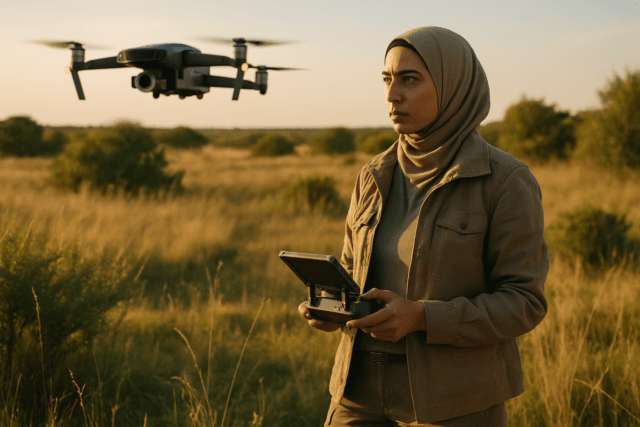The skies above us are increasingly populated by a new workforce: drones. These unmanned aerial vehicles (UAVs) are revolutionizing infrastructure inspection, offering unprecedented efficiency, cost-effectiveness, and safety in assessing everything from bridges and pipelines to wind turbines and power lines. However, as drones collect vast amounts of high-resolution imagery, sensor readings, thermal data, and more, a critical question emerges: how secure is this invaluable, often sensitive, infrastructure information? Ensuring robust data security for drone-collected infrastructure information is not merely a technical consideration but a paramount necessity to prevent financial losses, reputational damage, and legal repercussions.
The Data Revolution in Infrastructure Inspection
Drones equipped with advanced sensors and cameras can gather diverse data, including high-resolution images, video feeds, thermal scans, LiDAR data, GPS coordinates, and operational telemetry. This rich dataset enables precise identification of defects, informed maintenance strategies, and proactive risk mitigation for critical assets. The ability to access hard-to-reach or hazardous areas safely has made drones indispensable in this sector, transforming traditional, often dangerous, manual inspection methods.
Key Data Security Challenges in Drone Operations
While the benefits are clear, the proliferation of drone technology introduces a complex array of cybersecurity challenges that demand vigilant attention.
Vulnerable Communication Links
The wireless communication link between a drone and its ground control station (GCS) is a primary target for malicious actors. Many commercial drones rely on Wi-Fi or proprietary radio links that may lack robust encryption or authentication by default. This vulnerability makes them susceptible to:
- Passive Eavesdropping: Unauthorized listening or capturing of data during transmission.
- Active Jamming: Interference with the drone’s signals, potentially disrupting operations.
- Spoofing Attacks: Tricking the drone into receiving false GPS signals or control commands, which can divert the drone or lead to the collection of inaccurate, location-tagged data.
Onboard and Stored Data Vulnerabilities
The data stored directly on the drone or on removable media carries inherent risks. Physical access to a compromised or lost drone can lead to unauthorized data extraction or manipulation. Additionally, the sheer volume of data collected, potentially up to 150 TB daily for small fleets, presents a significant storage management challenge.
Ground Station and System Compromise
The ground control station (GCS) and its associated software are critical points of vulnerability. Malware targeting GCS systems can steal sensitive mission plans or collected data. Exploiting flaws in onboard drone software can also allow attackers to manipulate sensors or disable security features, leading to flawed scientific research, misinformed policy decisions, or manipulated environmental reports.
AI Manipulation and Autonomous Threats
As drones become more autonomous and integrate artificial intelligence (AI) for navigation and data analysis, new risks emerge. Hackers could tamper with AI algorithms, leading to erroneous decision-making or malfunctions. Data breaches can occur where sensitive information is processed by the AI system, and navigation control weaknesses can compromise drone operations.
Privacy Concerns and Regulatory Gaps
The collection of high-resolution imagery and detailed sensor data, particularly in public spaces or near private residences, raises significant privacy concerns. The absence of comprehensive, unified regulations governing drone usage and data collection across all jurisdictions complicates compliance and leaves individuals vulnerable to unchecked surveillance or misuse of their data. Compliance with data protection regulations like GDPR (General Data Protection Regulation) is crucial, especially when personal data is identifiable.
Robust Solutions for Drone Data Security
Mitigating these complex threats requires a multi-layered, proactive approach encompassing technological safeguards, stringent operational practices, and adherence to evolving regulatory frameworks.
End-to-End Encryption
Encryption is the cornerstone of drone data security, protecting information both in transit and at rest.
- Encryption in Transit: Data transmitted between the drone and the ground station (including video feeds, GPS coordinates, and control commands) should be encrypted using robust protocols like Advanced Encryption Standard (AES-128 or AES-256), Transport Layer Security (TLS), Secure Shell (SSH), or Virtual Private Networks (VPNs). Some advanced systems even split and encrypt data across multiple cellular links to prevent interception.
- Encryption at Rest: Onboard storage on the drone itself, as well as data stored on local servers or in cloud environments, must be encrypted. Standards like AES-128 or AES-256 are widely used. Effective key management, with encryption keys stored separately from the encrypted data, is critical for this process.
Strong Authentication and Access Control
Controlling who can access and control drone systems and data is paramount.
- Role-Based Access Control (RBAC): Implementing RBAC ensures that only authorized personnel can access sensitive drone data, limiting access based on their roles and responsibilities.
- Multi-Factor Authentication (MFA): Adding MFA provides an extra layer of security, requiring multiple verification steps for access.
- Digital Signatures and Tokenization: Verifying the identity of data senders and validating commands through digital signatures prevents unauthorized control and tampering. Sensitive data, such as GPS coordinates in defense applications, can be tokenized to protect against leaks.
- Zero Trust Architecture: Adopting a “never trust, always verify” approach ensures that every digital interaction, even within a trusted network, is authenticated and authorized.
Secure Data Transmission and Storage
Beyond encryption, the methods of data transmission and storage play a vital role in overall security.
- Secure Communication Protocols: Utilizing protocols such as HTTPS, SFTP, WebSockets over SSL/TLS (WSS), or IPsec for data transfer.
- Cloud Storage Solutions: Cloud platforms offer scalability, redundancy, and advanced security measures like encryption, access controls, and file versioning. Many providers are SOC 2 compliant and use AES 256-bit encryption for data in transit and at rest. Decentralized data storage across secure servers can also ensure data redundancy and availability.
- Physical Security Measures: Protecting drones and their storage media from physical threats like theft or tampering is an essential, often overlooked, aspect of data security.
Software, Firmware, and Hardware Security
The integrity of the drone’s operating system and components is crucial.
- Regular Updates: Consistent firmware and software updates are essential to patch vulnerabilities and enhance security features.
- Secure Software Development: Vendors should adhere to secure design and programming practices, ensuring that security is built in by default.
- Tamper-Proof Hardware: Utilizing hardware that can detect and alert users of physical tampering attempts.
Data Minimization and Privacy by Design
To address privacy concerns, organizations should adopt practices that limit data collection and protect personal information.
- Data Minimization: Only collect data that is necessary for the intended purpose. Software features can restrict data collection to predetermined paths or automatically erase data after secure download.
- Anonymization and Pseudonymization: Where possible, anonymize or pseudonymize sensitive data, such as blurring or removing human images, to minimize the risk of exposing personal information.
- Privacy Impact Assessments: Conduct thorough privacy impact assessments before commencing drone operations, especially in sensitive areas.
Regulatory Compliance and Best Practices
Navigating the legal landscape is complex, with regulations like GDPR in Europe and FAA Part 107 in the US dictating various aspects of drone operation and data handling.
- Adherence to Standards: Compliance with relevant regulations and industry standards (e.g., SOC2 Type II, ISO27001) is critical.
- Clear Policies: Establish clear data sharing agreements, data retention policies, and ethical use policies.
- Employee Training: Regular training and awareness programs for drone operators and maintenance personnel on cybersecurity best practices are vital.
The Future of Secure Drone Data for Infrastructure
As drone technology continues to evolve, so too will the methods for securing the data they collect. Emerging technologies like quantum encryption and blockchain are being explored for their potential to offer even more unbreakable data security and tamper-proof logs for communications. The continued focus on “privacy by design” and robust identity management systems for drones will further enhance the security posture of drone operations in critical infrastructure inspection. By proactively addressing these multifaceted security challenges, organizations can fully leverage the transformative power of drones while maintaining the integrity and confidentiality of the critical infrastructure information they gather.





